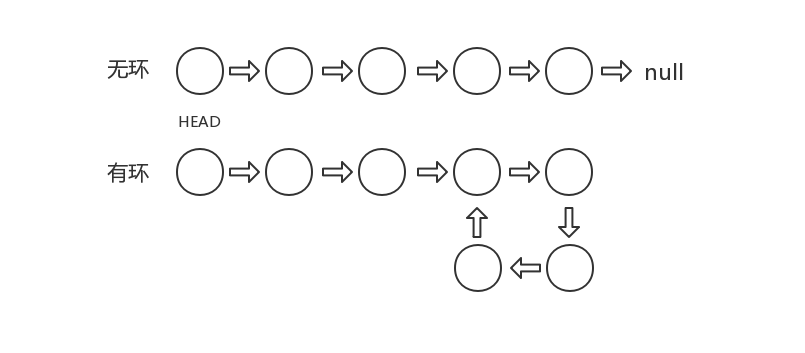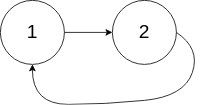本周练习内容:数据结构与算法 —— LinkedList
这些都是数据结构与算法,一部分方法是团队其他成员实现的,一部分我自己做的,有什么其他实现方法或错误,欢迎各位大佬指点,感谢。
一、链表是什么?与数组有什么区别?生活中有什么案例?
解析:
概念参考阅读 链表 —— 维基百科
1.概念:
链表(Linked list)是一种上一个元素的引用指向下一个元素的存储结构,链表通过指针来连接元素与元素;
链表是线性表的一种,所谓的线性表包含顺序线性表和链表,顺序线性表是用数组实现的,在内存中有顺序排列,通过改变数组大小实现。而链表不是用顺序实现的,用指针实现,在内存中不连续。意思就是说,链表就是将一系列不连续的内存联系起来,将那种碎片内存进行合理的利用,解决空间的问题。
所以,链表允许插入和删除表上任意位置上的节点,但是不允许随即存取。链表有很多种不同的类型:单向链表、双向链表及循环链表。
2.与数组的区别:
- 相同:
两种结构均可实现数据的顺序存储,构造出来的模型呈线性结构。 - 不同:
链表是链式的存储结构;数组是顺序的存储结构。
链表通过指针来连接元素与元素,数组则是把所有元素按次序依次存储。
链表的插入删除元素相对数组较为简单,不需要移动元素,且较为容易实现长度扩充,但是寻找某个元素较为困难。
数组寻找某个元素较为简单,但插入与删除比较复杂,由于最大长度需要再编程一开始时指定,故当达到最大长度时,扩充长度不如链表方便。
数组和链表一些操作的时间复杂度对比:
数组:
- 查找复杂度:O(1)
- 添加/删除复杂度:O(n)
链表:
- 查找复杂度:O(n)
- 添加/删除复杂度:O(1)
3.生活中的案例:
火车,是由一些列车厢连接起来;
寻宝游戏,每个线索都是下一个线索地点的指针。
二、请实现一个链表,并实现以下方法
append(element):向列表尾部添加一个新的元素。insert(position, element):向列表指定位置插入一个新的元素。remove(element):从列表中移除并返回特定元素(若有多个相同元素则取第一次出现的情况)。indexOf(element):返回元素在列表的索引(若有多个相同元素则取第一次出现的情况),如果列表中没有该元素则返回-1。removeAt(position):从列表中,移除并返回特定位置的一项。isEmpty():如果列表不含任何元素,返回true,否则返回false。size():返回列表中元素个数,与数组的length属性类似。toString():由于列表项使用Node类,需要重写继承自 JavaScript 对象默认的toString()方法,让其只输出元素的值。
提示:Web 端优先使用 ES6 以上的语法实现。
解析:
class Node {constructor(element){this.element = elementthis.next = null}}class LinkedList {constructor(){this.length = 0this.head = null}/*** 添加元素(末尾添加)* @param {*} element 添加的元素*/append(element){let node = new Node(element)if(!this.head){this.head = node}else{let current = this.head// 查找最后一项while(current.next){current = current.next}// 将最后一下的next赋值为node,实现追加元素current.next = node}this.length ++}/*** 添加元素(指定位置)* @param {Number} position 添加的位置* @param {*} element 添加的元素*/insert(position, element){if(position >= 0 && position <= this.length){let node = new Node(element),index = 0,previous = nullif(position === 0){node.next = this.headthis.head = node}else{let current = this.headwhile(index++ < position){previous = currentcurrent = current.next}previous.next = nodenode.next = current}this.length ++}}/*** 删除元素* @param {*} element 删除的元素* @return {*} 被删除的元素*/remove(element){let current = this.head,previous = nullif(element === this.head.element){this.head = current.next}else{while(current.next && current.element !== element){previous = currentcurrent = current.next}previous.next = current.nextthis.length --return current.element}}/*** 删除元素(指定位置)* @param {Number} position 删除元素的位置* @return {*} 被删除的元素*/removeAt(position){if(position >= 0 && position <= this.length){let current = this.head,index = 0,previous = nullif(position === 0){ // 删除第一项this.head = current.next}else{while(index++ < position){previous = currentcurrent = current.next}previous.next = current.next}this.length --return current.element}}/*** 查找指定元素的位置* @param {*} element 查找的元素* @return {Number} 查找的元素的下标*/indexOf(element){let current = this.head,index = 0while(current.next && current.element !== element){current = current.nextindex ++}return index === 0 ? -1 : index}/*** 链表是否为空* @return {Boolean}*/isEmpty(){return this.length === 0}/*** 链表的长度* @return {Number}*/size(){return this.length}/*** 将链表转成字符串* @return {String}*/toString(){let current = this.head,arr = new Array()while(current.next){arr.push(current.element)current = current.next}arr.push(current.element)return arr.toString()}}let leo = new LinkedList()leo.append(3)leo.append(6)leo.append(9)console.log(leo.length)console.log(leo.head)leo.remove(6)console.log(leo.length)console.log(leo.head)console.log(leo.toString())
三、实现反转链表
用链表的方式,输出一个反转后的单链表。
示例:
输入: 1->2->3->4->5->NULL输出: 5->4->3->2->1->NULL// inputlet head = {'val': 1,'next': {'val': 2,'next': {'val': 3,'next': {'val': 4,'next': {'val': 5,'next': null}}}}};reverseList(head)// outputhead = {'val': 5,'next': {'val': 4,'next': {'val': 3,'next': {'val': 2,'next': {'val': 1,'next': null}}}}};
解题思路1.使用迭代:
在遍历列表时,将当前节点的 next 指针改为指向前一个元素。由于节点没有引用其上一个节点,因此必须先存储其前一个元素。在更改引用之前,还需要另一个指针来存储下一个节点。不要忘记在最后返回新的头引用!
解题思路2.使用递归:
通过递归修改 head.next.next 和 head.next 指针来实现。
解析:
题目出自:Leetcode 206. 反转链表
介绍两种常用方法:
1.使用迭代:
在遍历列表时,将当前节点的 next 指针改为指向前一个元素。由于节点没有引用其上一个节点,因此必须先存储其前一个元素。在更改引用之前,还需要另一个指针来存储下一个节点。不要忘记在最后返回新的头引用!
/*** Definition for singly-linked list.* function ListNode(val) {* this.val = val;* this.next = null;* }*//*** @param {ListNode} head* @return {ListNode}*/let reverseList = function(head) {let pre = null, curr = headwhile (curr) {next = curr.nextcurr.next = prepre = currcurr = next}return pre};
复杂度分析
时间复杂度:O(n)。 假设 n 是列表的长度,时间复杂度是 O(n)。
空间复杂度:O(1)。
2.使用递归:
/*** Definition for singly-linked list.* function ListNode(val) {* this.val = val;* this.next = null;* }*//*** @param {ListNode} head* @return {ListNode}*/let reverseList = function(head) {if(head == null || head.next == null) return headlet pre = reverseList(head.next)head.next.next = headhead.next = nullreturn pre};
复杂度分析
时间复杂度:O(n)。 假设 n 是列表的长度,那么时间复杂度为 O(n)。
空间复杂度:O(n)。 由于使用递归,将会使用隐式栈空间。递归深度可能会达到 n 层。
四、判断链表是否有环
设计一个函数 hasCycle,接收一个链表作为参数,判断链表中是否有环。
为了表示给定链表中的环,我们使用整数 pos 来表示链表尾连接到链表中的位置(索引从 0 开始)。 如果 pos 是 -1,则在该链表中没有环。

需要注意的是,不可能存在多个环,最多只有一个。
示例 1:
输入:head = [3,2,0,-4], pos = 1输出:true解释:链表中有一个环,其尾部连接到第二个节点。

示例 2:
输入:head = [1,2], pos = 0输出:true解释:链表中有一个环,其尾部连接到第一个节点。

示例 3:
输入:head = [1], pos = -1输出:false解释:链表中没有环。

解题思路1.判断是否有 null:
一直遍历下去,如果遍历到 null 则表示没有环,否则有环,但是考虑到性能问题,最好给定一段时间作为限制,超过时间就不要继续遍历。
解题思路2.标记法:
也是要遍历每个节点,并在遍历的节点添加标记,如果后面遍历过程中,遇到有这个标记的节点,即表示有环,反之没有环。
解题思路3.使用双指针(龟兔赛跑式):
设置2个指针,一个 快指针 每次走 2 步,慢指针 每次走 1 步,如果没有环的情况,最后这两个指针不会相遇,如果有环,会相遇。
解析:
题目出自:Leetcode 141. 环形链表
1.断是否有 null
/*** Definition for singly-linked list.* function ListNode(val) {* this.val = val;* this.next = null;* }*//*** @param {ListNode} head* @return {boolean}*/let hasCycle = function(head) {while(head){if(head.value == null) return truehead.value = nullhead = head.next}return false}
2.标记法
/*** Definition for singly-linked list.* function ListNode(val) {* this.val = val;* this.next = null;* }*//*** @param {ListNode} head* @return {boolean}*/let hasCycle = function(head) {let node = headwhile(node){if(node.isVisit){return true}else{node.isVisit = true}node = node.next}return false};
3.使用双指针
/*** Definition for singly-linked list.* function ListNode(val) {* this.val = val;* this.next = null;* }*//*** @param {ListNode} head* @return {boolean}*/let hasCycle = function(head) {if(head == null || head.next == null) return falselet slow = head, fast = head.nextwhile(slow != fast){if(fast == null || fast.next == null) return falseslow = slow.next // 慢指针每次走1步fast = fast.next.next // 快指针每次走1补}return true};
五、实现两两交换链表中的节点
给定一个链表,两两交换其中相邻的节点,并返回交换后的链表。
你不能只是单纯的改变节点内部的值,而是需要实际的进行节点交换。
示例:
给定 1->2->3->4, 你应该返回 2->1->4->3.给定 1->2->3->4->5, 你应该返回 2->1->4->3->5.
解题思路1.使用迭代:
和反转链表类似,关键在于有三个指针,分别指向前后和当前节点,而不同在于两两交换后,移动节点的步长为2,需要注意。
解题思路2.使用递归:
这里也可以使用递归,也可以参考反转链表的问题,终止条件是递归到链表为空,或者只剩下一个元素没得交换了,才终止。
解析:
题目出自:Leetcode 24. 两两交换链表中的节点
介绍两种常用方法:
1.使用迭代:
/*** Definition for singly-linked list.* function ListNode(val) {* this.val = val;* this.next = null;* }*//*** @param {ListNode} head* @return {ListNode}*/let swapPairs = function (head){if(!head) return nulllet arr = []while(head){let next = head.nexthead.next = nullarr.push(head)head = next}for(let i = 0; i < arr.length; i += 2){let [a, b] = [arr[i], arr[i + 1]]if(!b) continue[arr[i], arr[i + 1]] = [b, a]}for(let i = 0; i < arr.length - 1; i ++){arr[i].next = arr[i + 1]}return arr[0]}
2.使用递归:
/*** Definition for singly-linked list.* function ListNode(val) {* this.val = val;* this.next = null;* }*//*** @param {ListNode} head* @return {ListNode}*/let swapPairs = function (head){if(head == null || head.next ==null) return headlet next = head.nexthead.next = swapPairs(next.next)next.next = headreturn next}
| Author | 王平安 |
|---|---|
| pingan8787@qq.com | |
| 博 客 | www.pingan8787.com |
| 微 信 | pingan8787 |
| 每日文章推荐 | https://github.com/pingan8787/Leo_Reading/issues |
| ES小册 | js.pingan8787.com |
微信公众号


